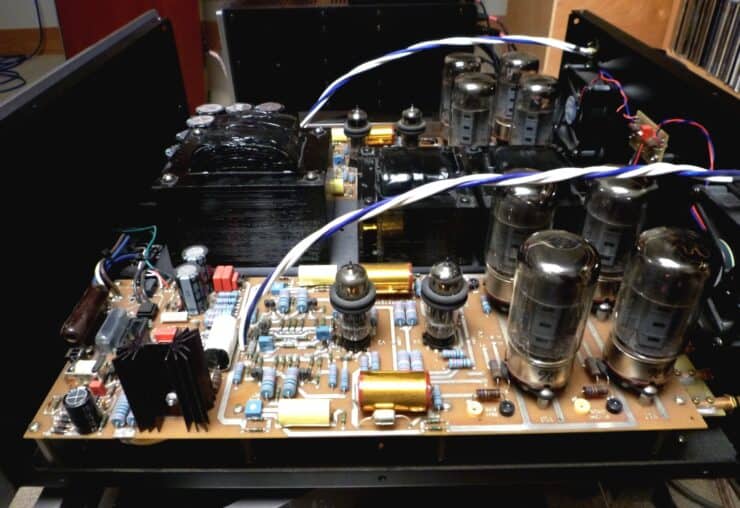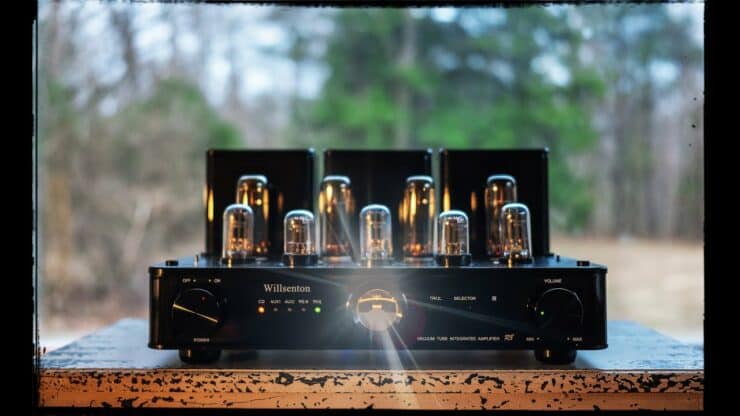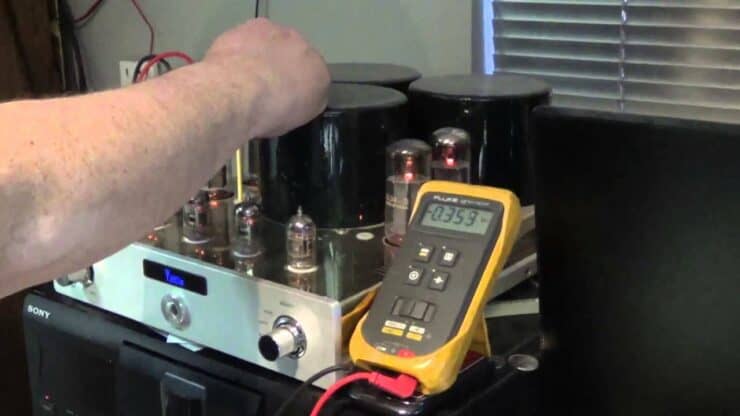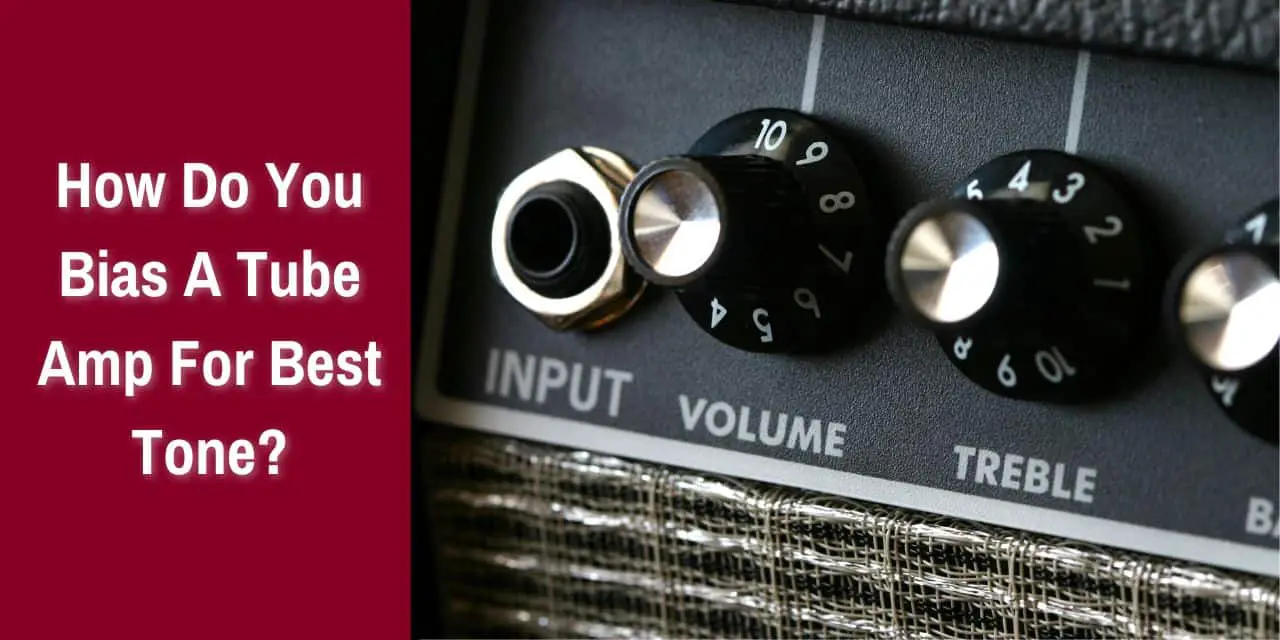Guitar players, if you’re looking to get the best tone out of your tube amp, then look no further! This article will provide an in-depth look at the process of biasing a tube amp, ensuring you get the most out of your setup. With the help of this guide, you’ll be able to make sure your amp is running at peak performance, giving you the best tone possible. So get ready to learn about biasing a tube amp, and get ready for the best sound you can get out of your setup!
What is tube bias?
Before talking about biasing in a tube amp, it’ll be important to find out what exactly is bias. The best way of understanding the concept of bias will be to think of it like the idle setting on any car. These days, most cars come with complex computers that control the idle. However, ultimately, the process is still the same as it always has been. The fuel and air mixture gets adjusted so that the motor runs smoothly. Too much of either of the two and the motor will not run very well, or not run at all. The idea here will be to find the perfect balance for optimum performance. This ideal is basically the same with the tube amps as instead of fuel and air, you will be dealing with electric current. The purpose of setting the bias in a tube will be to find the optimum setting for the flow of current when the tube amp is idling. Too much of it and the life of a tube could get decreased significantly and in some cases, failure might occur. This is referred to as “biased hot”. If it is too little, unpleasant or crossover distortion will be produced. This is known as “biased cold”. The appropriate setting is important for an amp to perform at its peak functionality and peak sound.
>>> Click here to read our review about the Top 15 Best Tube Amps <<<

Definition of tube bias
Tube bias is an important part of guitar amplifier technology. Essentially, it refers to the process of setting the correct electric current flowing through the output tubes of the amp. This process determines the sound quality of the amp.
Tube bias works by adjusting the voltage applied to the output tubes. The correct voltage will ensure that the tubes are operating at their optimal level. A bias level that is too low will cause the tubes to produce a weak sound. Meanwhile, a bias voltage that is too high will cause the tubes to produce a distorted sound. Therefore, it is important to set the correct bias voltage to ensure that the tubes operate efficiently.
How tube bias affects sound?
The sound of a tube amp is affected by the bias setting in multiple ways. When the tubes are under biased, they tend to produce a thin and weak sound. This is because they aren’t receiving enough current to operate at their optimal level. On the other hand, when the tubes are over biased, they will produce a distorted sound, which is often characterized by a harsh or buzzy tone.
The sound of an amp is also affected by the type of bias used. For instance, fixed bias is a type of bias where the bias voltage is set by a fixed resistor. This type of bias results in a more stable sound and is preferred by many musicians and guitarists. Cathode bias, on the other hand, is a type of bias where the bias voltage is set by the voltage across the cathode resistor. This type of bias produces a softer sound and is commonly preferred by guitarists and musicians looking for a more vintage sound.
It is important to note that the tube bias isn’t a one-time adjustment. As the tubes age, their operating characteristics can change and the bias voltage might have to be readjusted to maintain optimal performance. Regular maintenance and adjustments are important for ensuring that the amp continues to produce the best possible sound.
How do you bias a tube amp for best tones?
Some people wonder what’s the need to know how to bias a tube amp when they can just take their amp to a professional and get it biased. Or they may wonder if there is a common bias setting for all amps that they can use.
Although it might make sense that there could be an optimum setting where everyone can set the bias to that point and leave it, but the problem is that it doesn’t work like that. It is more akin to a moving target rather than an exact point. You should think of this as an acceptable range and not a single point. That is because each set of tubes will have a different performance characteristic that affects how the bias should be set. Even within a single brand of tubes, you are bound to find one set that varies wildly from the next set in terms of operating characteristics. This is one of the realities of vacuum tube production, and this has been the case since the beginning. For that reason, when you’re changing power tubes in a tube amp, it will be necessary to set the bias on the amp. This is why you need to know how do you bias a tube amp for best tone.
Not just that, biasing a tube amp also greatly impacts the sound of your amp and avoids damage to it while ensuring optimal sound quality. Here are the steps to follow for biasing a tube amp –
#1. Prepare the amp
Before you bias your tube amp, you will need to ensure that it is turned off and plugged from the power source. You must also remove the amp cover to access the tubes and the bias adjustment potentiometer. It is important that you follow the manufacturer’s instructions when you’re removing the cover and accessing the tubes.
#2. Adjust the bias
For adjusting the bias, you will need to locate the bias adjustment potentiometer, which is typically located near the output tubes. The potentiometer might be marked as “bias out” or “bias adjust”. Using a small screwdriver, you have to turn the potentiometer clockwise or anticlockwise slowly until you reach the desired bias voltage.
It is important to note that different tube amps come with different bias voltages. This is why it is important to check the manufacturer’s specifications before you adjust the bias. You can also refer to the online resources or consult a professional technician for guidance.
#3. Test the bias
Once you have adjusted the bias on your tube amp, you will need to test it to ensure that it is set correctly. You will require a multimeter for measuring the voltage across the output tubes. Place the multimeter leads on the test points provided on the amp, generally near the output tubes. Then, set the multimeter to DC voltage and then turn on the amp.
Check the voltage reading on the multimeter and compare it to the manufacturer’s specifications. If the voltage reading falls within the recommended range, then your bias is set correctly. If the voltage reading is too low or too high, then you will have to readjust the bias until you get the correct reading.
It is important to note that biasing a tube amp is dangerous, so you should be careful. Moreover, it is recommended that you consult a professional technician if you are unsure about the process or do not have experience with electronics.

Different types of bias in a tube amp
When it comes to tube amps, bias is a significant aspect to consider, as it can greatly affect the sound quality and lifespan of your tube amp. Bias refers to the electrical setting that determines the flow of current through the tubes. There are several types of bias used in tube amps, each with its own characteristics and advantages. Here are the most common types of bias in a tube amp –
#1. Cathode bias
Cathode bias is a popular type of bias used in tube amps. This type of bias makes use of a resistor connected to the cathode to the output tube for controlling the current flow. The bias is self-regulating, meaning that it adjusts automatically as the tubes heat up. Cathode bias provides a softer and more compressed sound compared to fixed bias.
Cathode bias amps tend to be the least work-intensive, since they don’t require that much biasing in a general sense. Many people refer to this type of bias as “self-biasing” for that reason. Without getting into that much technical jargon, essentially through a series of design characteristics, primarily through a resistor, these amps will balance themselves against the current draw of the given set of power tubes. For that reason, they’ll typically function quite well with a wide range of vacuum tubes without needing any adjustment. Basically, it is “plug and play”; however, it is still recommended that you should purchase a matched set of tubes for optimal performance. Cathode biasing is common in lower-powered amps, and even more so in amps that feature EL84s. However, this design is slightly tricky to incorporate in higher-powered amps. This is one of the reasons why their use in tube amps is rather limited.
#2. Adjustable fixed bias
Adjustable fixed bias may sound like an oxymoron, but it is the best way of describing this type of biasing. The bias in this case comes pre-set to a fixed point depending on the performance of the tubes. Normally, a technician will take a series of readings while the amp is idling to establish the proper amount of current a tube needs to be drawing. Then, through an internal adjustment pot, you’ll set the bias based on this info. It isn’t an extremely difficult process, but it can be slightly dangerous if you don’t know what you’re doing, as it often requires the person to take internal readings with the amp plugged in and turned on. With this biasing method, it is recommended that the bias should be checked after you have replaced the power tubes, unless the net set of tubes happens to be identical to the set being replaced.
#3. Non-adjustable fixed bias
With this type of biasing, as the name implies, the bias cannot be adjusted easily. The settings are pre-set to a fixed point by design to work with a wide range of tubes. Similar to cathode biasing, non-adjustable fixed bias is essentially “plug-and-play”. However, the results may vary slightly, given the different operating characteristics of each set of tubes. For that reason, it’ll be helpful to go for tubes that are matched or graded based on a different set of characteristics. Since it can be difficult to optimize the amp for the set of tubes like the previous methods, it is important that you optimize the tubes to the amp based on its operating characteristics.
#4. Grid bias
Grid bias is a less common type of bias used in certain tube amps. This type of bias makes use of a positive voltage applied to the control grid of the output tubes for controlling the current flow. The bias is set using a potentiometer, and it will remain fixed until it is adjusted again. Grid bias provides a more aggressive sound compared to fixed bias, making it popular among rock and metal guitarists.
#5. Auto-bias
Auto bias or also known as self-bias is a type of bias that uses a sensing circuit for measuring the current flow through the tubes and adjust the bias accordingly. This type of bias is popular among guitarists who want a hassle-free biasing experience, as it eliminates the need for manual adjustment. Auto bias is typically more expensive than other types of bias due to the additional circuitry required.

When is it necessary to bias tube amps?
On 95% of tube amps, you will need to bias the amp every time you change the tubes. However, some amps do not need to be biased. There are tube amps like Mesa/Boogie amps that come with fixed bias settings out of the box. This means that you will be able to change the tubes for other Mesa/Boogie tubes without having to worry about bias. You can then easily use the appropriate tube spec in your Meta/Boogie tube amp.
Generally, most brands don’t test tubes before shipping them. This is why they may vary greatly in terms of resistance. For instance, imagine your tube amp is set to run when it is hot, and it has high-resistance tubes that match perfectly. However, you want to change the brand or specifications of the tube.
If you’ve changed the tubes to a lower resistance without biasing your tube amp, you’ll quickly burn through the tubes and potentially damage not just your amp, but injury yourself in the process too. This is due to the tube amp still pushing the current at a higher level compared to what the valves can handle. It’ll be a dangerous situation until it has been biased correctly.
In simple terms, having the appropriate tube amp bias will help you make sure that your power amp valves are running at their optimum levels. This means that you’ll get the best possible tone out of the tubes as they are being fed the correct voltage as per the valve’s resistance. Having the correct biasing will mean that the valves can have a long life as they are running at the ideal temperature. However, if you do not bias the amp correctly, you will face these scenarios –
#1. Run the valves too cold
This means that there is not enough voltage isn’t being delivered to the power amp valve. This will result in a thin, sterile sound without the lovely warm tube saturation. Valves will likely have a longer life as they aren’t getting overworked. However, the amp will still not sound the best that it possibly can.
#2. Run the valves too hot
This means that you are cooking and saturating the valves far too quickly. This can cause major issues for your amp as you are allowing too much power through the power amp circuit. At best, you may get an overly saturated tone that has a much shorter valve life than expected. At worst, you will end up melting other components in the amp further down the line or even start a fire.
#3. Run the valves at optimum
This is between the hot and cool range, where the valves can resist the power coming at them perfectly. Happy valves will result in a happy tone and a very happy musician or guitarist. This balance will be helpful for the tube’s life and result in the best tone.
Tips for biasing a tube amp
Adjusting the bias of a tube amp is an integral aspect of achieving the desired sound quality. It involves setting the current flowing through the tubes to make sure that they operate within their safe limits and produce optimal sound. Adjusting the bias on tube amps is pretty easy and can be done in different ways depending on the type of tubes you’re using and the sound you’re trying to achieve –
Adjusting the bias for different tubes
Different types of tubes require different bias settings. The bias setting for a particular tube is typically specified by the manufacturer and can be found in the amp’s owner’s manual or the tube’s datasheet. For adjusting the bias for different tubes, you will need to find the bias adjustment potentiometer on your amp’s circuit board.
Then, you will need to connect a multimeter to the bias test points on the circuit board. With the tube amp turned on and idling, you should measure the voltage across the test points. Adjust the potentiometer until the voltage reaches the desired value. You must be careful when adjusting the bias as excessive current flow could damage the tubes or other components in your amp.
Adjusting the bias for different sounds
Aside from adjusting the bias for different tubes, you can also adjust the bias for achieving different sounds. Bias adjustment can affect the harmonic content, output level, and dynamic response of the amp. For instance, a hotter bias setting could produce a brighter and more aggressive sound, whereas a colder bias setting can produce a darker and more compressed sound.
For adjusting the bias for different sounds, you will have to experiment with different bias settings and listen to the output of the amp. Begin by adjusting the bias in small increments and listen for any changes in the sound. You should take note of how different bias settings affect the output level, harmonic content, and dynamic response. With enough practice, you’ll quickly develop an ear for different bias settings and be able to achieve the best tone more easily.
FAQs
What is biasing a tube amp, and why is it important?
Biasing a tube amp involves adjusting the current in the output tubes in order to optimize the amplifier’s tone. This process is important because it allows you to get the most out of your amp and ensure it produces the best possible tone.
What are the benefits of biasing a tube amp?
Biasing a tube amp can produce improved tone and clarity, better sustain, and smoother distortion. Bias adjustments can also increase the amp’s headroom, allowing for more dynamic playing.
How do you bias a tube amp for best tone?
Bias adjustments should be performed by a qualified technician, as incorrect bias settings can damage the amp. The best way to ensure your amp is biased correctly for the best tone is to have it serviced by a qualified technician who can adjust the bias levels for optimum performance.



